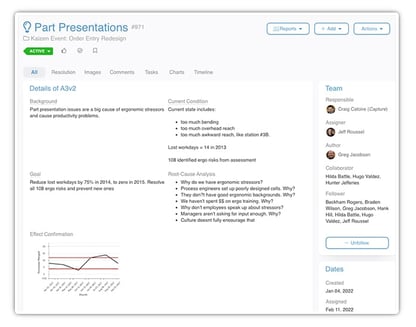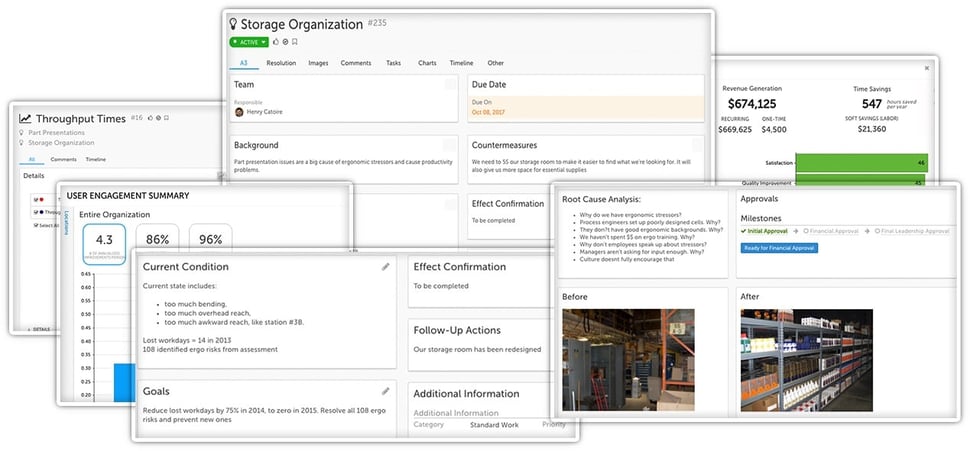 Before we dig into the topic of A3 problem solving and software, here’s a little peek into how the sausage is made for this blog. One of the ways we decide which topics to cover is that we take a look at what improvement related terms people are searching for, and if we have something useful to add to the conversation, we write about it. We can’t really say that Lean management and improvement terms “go viral,” but there are definitely trends in what people want to learn more about.
Before we dig into the topic of A3 problem solving and software, here’s a little peek into how the sausage is made for this blog. One of the ways we decide which topics to cover is that we take a look at what improvement related terms people are searching for, and if we have something useful to add to the conversation, we write about it. We can’t really say that Lean management and improvement terms “go viral,” but there are definitely trends in what people want to learn more about.
Lately, we’ve noticed that interest in the A3 method of problem-solving is increasing. That’s probably because more organizations are looking for a simple, yet effective way to streamline improvement projects and set a standard for how to report on these efforts.
Here’s how the approach got started and how it has changed with the times.
More Than a Piece of Paper
The A3 problem-solving technique was developed by Toyota in the 1960’s and later adopted by practitioners of Total Quality Management, Six Sigma, Lean Management, and other organized approaches to improvement. A3 refers to a European paper size that is roughly equivalent to an American 11-inch by 17-inch tabloid-sized paper. Using the A3 approach, teams create a one-page project report. Limiting the report to one page is intended to make it more readable and understandable. Anything longer is considered not concise enough.
A3s Typically Include:
Header: This includes basic information about the organization or the team or department working on this project.
Background: This describes the need for the project and outlines the problem.
Current State: Here the situation as it exists today is described. Typically, it will include graphs and illustrations. It is based on data, not assumptions.
Problem: This section includes analysis of the current state. The goal is to identify the root cause of the problem so that improvements will result in effective and useful change.
Future State: This section includes details about the specific goals, and any countermeasures imagined.
Implementation Plan: This critical piece outlines the Who, What, and When, laying out the action items and timing of the project. It should also include reporting plans for the project.
Results: Once the changes are implemented the results are compared to the plan and analysis is presented about the total long-term effect of the project on the organization. Results may include cost savings, quality improvement, reduced waste, improved customer satisfaction, or any other business objective of the organization.
The Modern Approach
Of course, a lot has changed about the way people work since the 1960s. Today, teams are more likely to be spread out. Management is also more reliant on real-time information and interested in creating a repository of institutional knowledge about improvement work. That’s why so many teams are looking to A3 software to capture the benefits of the approach while adding the power of modern databases and internet technology to serve as a force multiplier.

A3 software enables:
Standardization: With software designed for the purpose in place, the A3 process is standardized regardless of who is involved in the project or what type of improvement they are working on. It also provides a structure with active notifications and a single format. The best solutions let you configure the report and workflows for a process that makes sense for how your organization works.
Visibility: These days, leaders require real-time visibility into the improvement work that is taking place. This allows coaches to be proactive and increases accountability across the board. Look for a solution that lets you drill down into the details of each A3 and one that captures the impact of improvement work.
Collaboration: Many improvement projects require the involvement of cross-functional teams. That’s why web-based A3 software platforms with built-in collaboration tools are so popular. The right people can be involved in every project, regardless of where they are located, and they have access to all of the information they need when they need it.
Visual Management: A3 is based on the idea that improvement projects are easier to communicate if they are consistently arranged for maximum speed to understanding. This is true of A3 software as well.
Applying today’s technical advantages to the tried and true approach of A3 problem solving helps organizations accelerate improvement and get even more impactful results. It also creates a repository of knowledge so that each A3 can build on the success of the last. With all the advantages of A3 problem solving, especially when it is powered by software, we’re not all surprised that it is a popular term to search.
![[Watch Now] How to Use A3 Thinking in Everyday Life](https://no-cache.hubspot.com/cta/default/326641/312227ef-895d-48da-b9ee-ee61a5b19930.png)
![[WEBINAR] A Deep Dive into A3 Thinking](https://no-cache.hubspot.com/cta/default/326641/a78d9f1b-c108-4709-8a9d-9dd5a8a020b3.png)



Add a Comment